
A long, narrow country squeezed in between the East Sea and the Laos and Cambodia borders, Vietnam is a land of striking landscapes that range from the lush rice terraces and forested mountains in the north to the picturesque valleys of the Central Highlands and the fertile delta and beautiful beaches of the south. Included in the mix are booming modern cities, colonial towns, traditional villages, archaeological sites and otherworldly islands.
A long, narrow country squeezed in between the East Sea and the Laos and Cambodia borders, Vietnam is a land of striking landscapes that range from the lush rice terraces and forested mountains in the north to the picturesque valleys of the Central Highlands and the fertile delta and beautiful beaches of the south. Included in the mix are booming modern cities, colonial towns, traditional villages, archaeological sites and otherworldly islands.
An overview of the best places to visit in Vietnam by touropia.com, a travel list website that features the most amazing sights around the world divided into various “best of” lists.
10. Da Lat
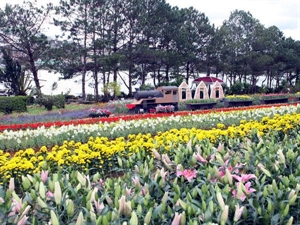 |
Year-round cool weather and idyllic scenery of misty valleys, lush pine trees and colorful flowers are some of the reasons that Da Lat was once used by Vietnamese emperors and French colonials as a summer retreat. Today, this charming town in the South-Central Highlands of Vietnam is a popular destination for honeymooners, weekend getaways and for those looking for relief from the heat.
A walkable city, Dalat is a beautiful scene of French colonial architecture and villas set amid picturesque landscapes. The city is well known for its royal palaces owned by the last emperor of Vietnam. These lovely palaces are open for tours as is the Hang Nga Guesthouse, the city’s most bizarre attraction. Informally called the “Crazy House”, this structure is a fantastical construction with caves, spider webs and shapes of animals and mushrooms. Dalat’s lively market is a great place to find fruits, flowers and vegetables grown in the local area as well as handicrafts and silk embroidered items.
Outside the city are scenic lakes, flower gardens, historic monasteries, plantations and mountains offering pretty waterfalls and trails for hiking and mountain biking. A must-do is the Valley of Love, an incredibly beautiful valley with pine forests, flowers and lakes where tourists can enjoy pedal-boating, horse riding, jeep safaris and canyoning.
For dining and nightlife, Dalat offers numerous cafes and restaurants to suit every budget and taste from regional dishes to French and Western cuisines as well as a few bars and nightclubs.
9. My Son

Located on the central coast of Vietnam near the Duy Phu village is the important archaeological site known as My Son. One of Southeast Asia’s most notable heritage sites, My Son was once a significant center of religious Hindu ceremonies where the kings of the Champa Kingdom built numerous temples devoted to the worship of the god, Shiva, between the 4th and 14th centuries.
Believed to have once contained more than 70 temples that were constructed with brick and decorative carvings and sculptures bearing scenes of animals, priests, gods, mythical battles and inscriptions of Sanskrit and Champa, My Son today features a complex of ruins in varying states of disarray and repair, all arranged in several groups that are marked by letters of the alphabet.
Within the site is a museum where visitors can check out exhibits and artifacts to better understand and appreciate the ruins. Near the entrance of My Son are a few cafes, food vendors and a shop selling souvenirs. At certain times of the day, visitors can watch live Champa dance performances. Additionally, the site is surrounded by jungle, hills and a lake where visitors can enjoy hiking and kayaking.
My Son is often reached by organised tour groups in vans and buses from Hoi An. However, visitors can also arrive at My Son by motorbike taxis and motorbike rentals.

Lying along the Saigon River near the Mekong Delta in southern Vietnam, Ho Chi Minh City was formerly known as Saigon and served as the capital of South Vietnam during the Vietnam War. Today, Ho Chi Minh City is the largest city of the reunified country, offering plenty of reasons to visit, from its blend of historic and modern attractions to vibrant shopping, dining and nightlife.
Ho Chi Minh City is most commonly explored by motorbike taxis, but buses and car taxis are also plentiful. Sightseeing the city’s centre awards elegant boulevards lined with French colonial architecture, beautiful churches, pagodas and prominent landmarks like the Reunification Palace, City Hall, the Opera House and Notre Dame Cathedral. A number of museums exhibit war history and local culture.
The city’s business and entertainment district offer modern attractions like the Bitexco Financial Tower skyscraper and the Dai Nam Tourist Park, which features a man-made mountain range, zoo, temples, hotels, shops and restaurants. The Night Market and the Ben Thanh Market are lively places to buy food, handicrafts, souvenirs and experience local food and culture. Outside the city, jungle and river tours are available to see bamboo villages and floating temples.
From market stalls to street vendors, cafes, coffee shops and international restaurants, Ho Chi Minh City offers the largest variety of dining choices in Vietnam. Local cuisine consists of traditional dishes like Pho (beef and chicken noodle soups) and Com tam (a plate of rice, grilled pork and vegetables). Nightlife in Ho Chi Minh City buzzes with a wide selection of bars, lounges, nightclubs and theaters.
7. Mekong Delta
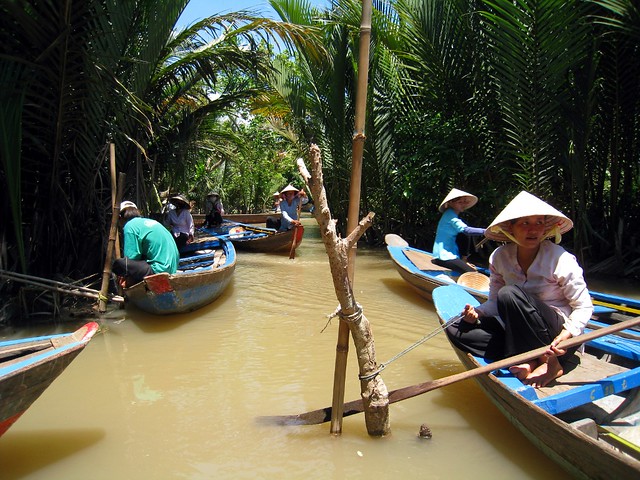
With plenty of bus connections and motorbikes, tourists can explore the Mekong Delta and its towns like Tra Vinh, which is considered one of the prettiest villages of the delta. Many towns in the region provide shops, restaurants and hotels for travelers. Others places like Hon Chong, feature attractions like pictorial stone grottoes, while Ben Tre is dominated by fruit orchards, Sa Dec is rife with colorful flower farms, and Cao Lanh is a paradise for bird lovers. The beautiful island of Phu Quoc offers scuba diving, snorkeling, kayaking and hiking. Just outside Chau Doc, Sam Mountain presents temples and lovely views. A river boat cruise in Vinh Long brings tourists to a floating market teeming in busy workers and fresh produce and fish.
6. Nha Trang
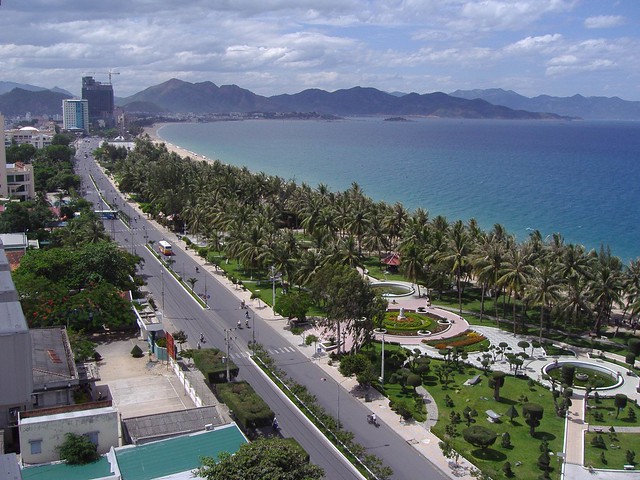
Located on one of Asia’s most beautiful bays off the coast of South Central Vietnam, Nha Trang is a popular seaside resort city. Picturesque mountains, beaches and lush islands all make it a favorite destination among tourists, Vietnamese and scuba divers.
Adorned with resorts, palm trees and a lovely promenade, Nha Trang’s beach is its main draw. As a popular stopover for sea cruises and annual Hong Kong yacht races, Nha Trang and its beach offer plenty of water activities such as scuba diving, snorkeling, kite boarding, sailing and catamaran rides. Amusement and water parks provide fun for everyone with roller coasters and wave pools.
Within the city of Nha Trang, tourists can visit a few important landmarks like pagodas, the Nha Trang Cathedral and the historic Po Nagar Cham Towers. The Nha Trang Oceanography Institute is home to an aquarium housing thousands of ocean creatures. Just outside the city, tourists can enjoy river boat cruises and explore the picturesque countryside, fishing villages, plantations, waterfalls and natural hot springs.
Dining choices in Nha Trang are abundant for every budget and taste from casual sidewalk cafes to high end restaurants. The city’s cuisine is known for its seafood dishes as well as bird’s nest soup and barbecued pork rolled in rice paper. Bars, lounges and clubs provide plenty of nightlife options.
Nha Trang is easy to explore by walking and cycling, but tourists can also get around by buses, taxis, motorbikes and cyclos (three-wheeled motorised vehicles).
5. Sapa

Surrounded by pictorial mountains, rice terraces and a diversity of hill tribes in the remote northwest of Vietnam, Sapa is a quiet town frequently used as a base for trekking in the Hoang Lien Son Mountains and touring rice paddies and traditional villages.
Sapa’s main attraction is its proximity to the mountains, villages and rice terraces. From the town, there are many organized tours that aide tourists in mountain hikes and exploring the nearby rice paddies and remote villages. These tours present views of wildlife, beautiful waterfalls and the opportunities to experience the food, customs and way of life among the local tribes.
In the town of Sapa itself, there are attractive French colonial sites worth visiting such as the Gothic church, the town square and city hall. Sapa is a major market town where the various ethnic tribes in the area often gather to sell their handicrafts, which make excellent souvenirs. At the Sapa Culture Museum, visitors can learn all about the history and cultures of these ethnic groups.
Because it is a popular tourist base, Sapa boasts a wide variety of restaurants ranging from traditional Vietnamese to international cuisines. At the town market, food stalls serve the local specialty, hot pot, a simmering broth of meat, greens and mushrooms. Nightlife options are limited in Sapa, but there are a few bars where one can enjoy drinks, music and socializing.
Getting around Sapa is easily done by walking, but exploring outside of town should be done by organised tours, motorbikes and 4WD vehicles that can be rented at hotels.
4. Hue

Situated on the banks of the Perfume River in Central Vietnam, Hue once served as the imperial capital of the Nguyen dynasty, which ruled from 1802 to 1945. Today, the vestiges of this former glorious period are reflected in the city’s architecture, culture and cuisine, making it a popular tourist destination.
Hue is a compact city, making it easy to get around by walking although motorbikes, cyclos and taxis are plentiful. The city’s main attractions are its well-preserved historic monuments that mostly lie along the Perfume River, a scenic river so named from the pleasant aromas of flowering orchards. Of the city’s monuments, the Citadel is the most famous. Once the seat of the Nguyen emperors, the Citadel is a sprawling complex of grand palaces, ornate temples, walls and gates. Prime attractions within the Citadel are the Forbidden Purple City, Thai Hoa Palace, and the Ngo Mon Gate. Another important landmark on the river is the city’s official symbol, the Thien Mu Pagoda.
Just a short bicycle ride or scenic river cruise outside of the city is the must-see Tombs of the Emperors, an elaborate tomb system of which the Tomb of Tu Duc is the finest. While exploring the tombs, tourists may also want to visit the nearby hot springs and spas for a bit of pampering and relaxation.
Hue’s cuisine is another of its attractions, noted for its refined presentations that date back to the imperial period. Popular local dishes are Nem lui (sweet pork grilled on bamboo sticks) and Banh khoai (a pancake of shrimp, pork and bean sprouts). Hue offers a good supply of cafes, restaurants, bars and clubs.
3. Hoi An
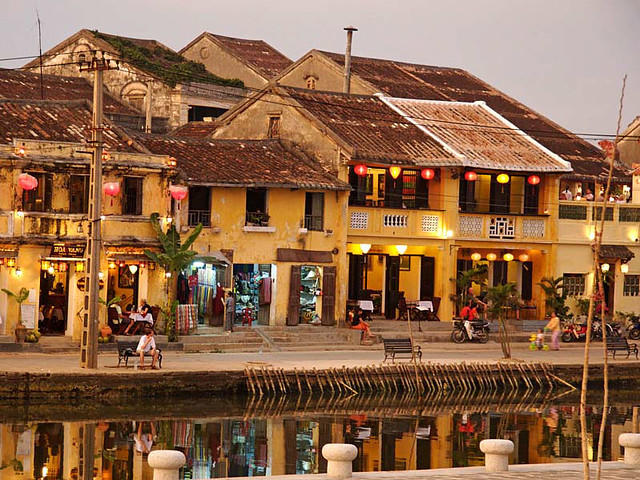
Located off the coast of the East Sea in South-Central Vietnam, Hoi An is a beautiful, old city dating back 2,000 years to the Champa Kingdom. The city’s historic architecture, traditional culture and textiles make it a popular destination in Vietnam.
At the heart of Hoi An is its atmospheric Old Town, which is small enough to walk around easily. The narrow, winding lanes of the Old Town are lined with beautiful old architecture, traditional wooden houses and hundreds of tailor shops selling clothing, shoes, bags, souvenirs and custom-made services. The central market is here as well, bustling with vendors selling fresh food, cooked dishes, ceramics and handicrafts. Important landmarks not to miss are the 17th century Japanese covered bridge, the Quan Cong Temple and the Cantonese Assembly Hall.
Outside the historic center, motorbikes and taxis provide transportation around a more modern district booming in attractions, museums, hotels, restaurants, shops and tourist facilities. To experience the city’s historic culture, the Hoi An Handicraft Workshop and the Traditional Theatre present performances of folk customs and music. Bicycle tours to nearby villages offer picturesque countryside, rice paddies, water buffalos and traditional cuisine.
Hoi An has a good range of restaurants, pubs and clubs. Many of the city’s restaurants offer cooking classes, so visitors can learn to cook the city’s local specialties that include Cao lau (rice noodles topped with roasted pork, vegetables and dough fritters) and White rose (a shrimp dumpling shaped to resemble a rose).
2. Hanoi

For the last century, Hanoi has survived through the invasions and occupations of Japan and France as well as the Indochina and Vietnam Wars to emerge as the booming capital city of a reunified Vietnam. Located on the banks of the Red River in northern Vietnam, Hanoi is a large city offering more than 1,000 years worth of history and culture now blended with modern attractions, dining, shopping and nightlife.
At the heart of Hanoi is its Old Quarter, an open-air museum of historic Asian and French colonial architecture that has largely remained intact despite the bombings of the Vietnam War. Here among scenic tree-lined boulevards, tourists can browse busy markets, sip coffee at quaint cafes and visit prominent sites like the Grand Opera House, the Presidential Palace and Saint Joseph Cathedral. Beyond the Old Quarter, the city is full of impressive temples and museums exhibiting the country’s eventful history.
Hanoi has many beautiful lakes surrounded by parks and green spaces with the most popular being Hoan Kiem Lake. A good way to experience the local culture is to attend a live performance of Ca trù, a traditional form of Vietnamese music, or to see history and folklore demonstrated at the Thang Long Water Puppet Theatre. One of Asia’s top shopping cities, Hanoi is teeming in malls and shopping centers.
Hanoi’s dining scene is vibrant from numerous market stalls and street vendors selling traditional dishes like Pho bo (Beef noodle soup) and Pho ga (chicken noodle soup) to fine restaurants serving a variety of Asian and international cuisines. Nightlife choices are plentiful from karaoke bars and dance clubs to cinemas and theaters. The best options for getting around Hanoi are bus, taxi and motorbike taxi.
1. Ha Long Bay
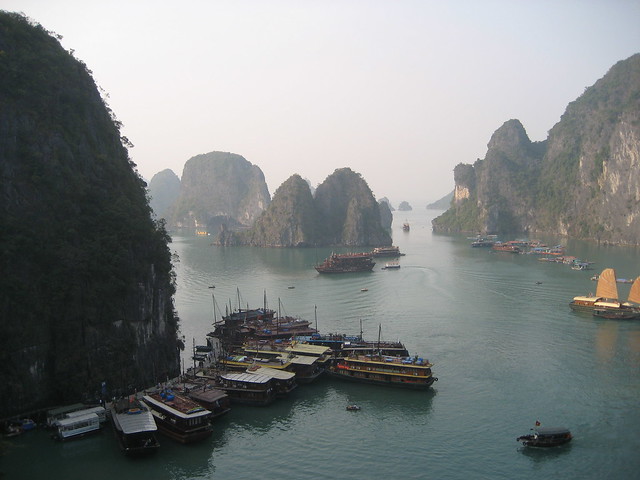
With its aqua-green water and cluster of limestone rocky outcrops rising from the water like sea dragons, Ha Long Bay resembles a scene from a fantasy story. Located about 130 km east of Hanoi in northern Vietnam, this otherworldly bay features more than 2,000 jungle-covered islands pitted with intriguing caves, grottoes, sinkholes and lakes. Ranging between 50 and 90 metres high, many of the islands and outcrops have been sculpted over the centuries by natural processes into fantastic formations. The names of these islands reflect the unusual shapes they resemble such as Voi (elephant) islet, Mai nha (roof) islet and Ga choi (fighting cock) islet.
Although most of the islands are uninhabited, some of the larger islands such as Cat Ba offer restaurants, bars, hotels and tourist attractions like beaches, historic sites, a national park, markets and souvenir shops. Other islands like Dau Be and Bo Hon feature lakes, coral and grottoes that are ideal for swimming, kayaking, diving and cave-exploring. Rock climbing, jungle trekking and wildlife viewing are also available activities.
Boat cruises are the best way to experience the natural wonder of Ha Long Bay. With hundreds of boats ranging from traditional Chinese junks to luxury cruisers, boat tours can vary from day trips to multiple-night journeys. These tours often provide meals, nightlife activities and excursion stops where islands, caves and lagoons can be explored. Most boat cruises are arranged either from Hanoi or from ports such as Hai Phong, Halong City and Cai Rong.




